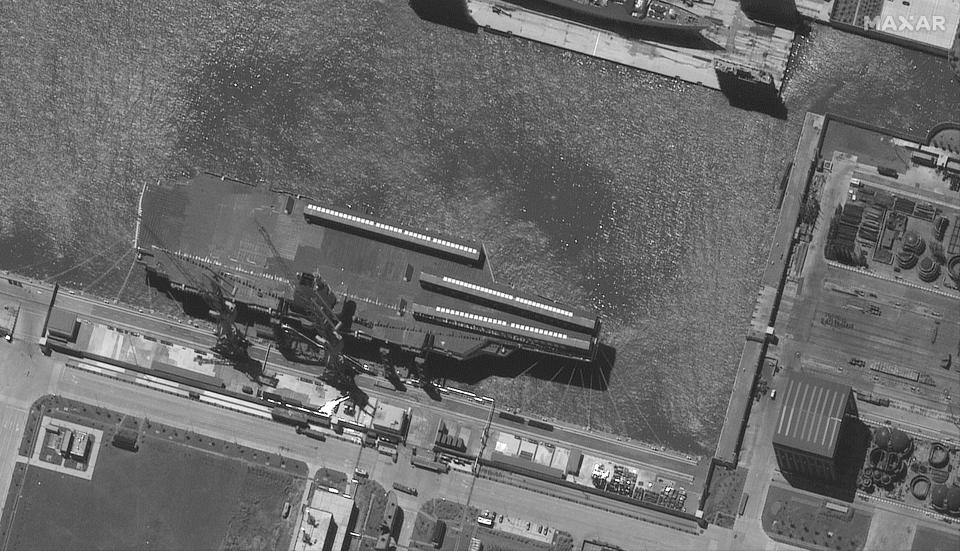China's newest aircraft carrier was spotted with aircraft mock-ups hinting at what its future air wing could look like
New images posted to social media show China's third and newest aircraft carrier hosting aircraft mock-ups.
It's a notable step before the Fujian's upcoming sea trials, showing what its future air wing might look like.
The Fujian is a large, modern ship expected to be a major upgrade to China's naval capabilities.
China's newest aircraft carrier appears to be sporting mock-ups of warplanes, according to new images posted to social media by a long-time China watcher.
It's a major step for the Fujian, as the People's Liberation Army Navy looks to put its largest, most advanced carrier through sea trials and push it closer to being ready for operations.
Images of the Fujian, also identified as Type 003, docked in Shanghai were posted on X this week. On Tuesday, Andreas Rupprecht, a China aviation observer and researcher, also shared the images, discussing their significance. The Fujian's mock-ups were first reported by The War Zone.
After a slightly longer pause with only blurry images, here is a new recent update showing the PLANS-18 „Fujian“ at Shanghai with the painted deck markings and all the aircraft mock-ups (KJ-600, J-15 & J-35). pic.twitter.com/XWmpq1KkPL
— @Rupprecht_A (@RupprechtDeino) April 16, 2024
Closer examination of the flight deck revealed that the Fujian is currently hosting five mock-ups: a KJ-600 airborne early warning and control aircraft, two fourth-generation J-15 carrier-based fighters, a fifth-generation J-35 fighter that is still in some stage of development, and a JL-10J advanced jet trainer and light combat aircraft.
Thanks to @QwaSkkn2447 I missed, that there is not only the KJ-600, J-15 & J-35 but altogether 5 mock-ups including a second J-15 and the JL-10J. pic.twitter.com/cLIQim5iKO
— @Rupprecht_A (@RupprechtDeino) April 16, 2024
The mock-ups appear to simulate where the aircraft would be on the carrier's deck. The pictures also show the Fujian's catapult system, designed to launch aircraft much like the US Navy's aircraft carriers. The Fujian is China's first carrier to feature this technology, as previous carriers have launched aircraft with ski jumps, upward ramps at the end of the deck. China's two other carriers, the Liaoning and Shandong, both feature ski jumps.
Back in January, Chinese state media showed aerial footage of the Fujian featuring three catapult tracks and an aircraft mock-up. Catapult launch systems are much more effective than ski jumps, easing the strain of takeoff on the aircraft and allowing for the launch of larger fixed-wing planes with heavier payloads and more fuel.
The Chinese carrier relies on conventional power, as opposed to nuclear like US carriers, and steam turbines, but the ship's catapults are electromagnetic, like those on the US Navy's new Ford-class aircraft carriers.
The Fujian's catapults are a notable jump in technology. The Department of Defense said in 2019 in its annual China military power report that the carrier's "design will enable it to support additional fighter aircraft, fixed-wing early-warning aircraft, and more rapid flight operations."
Before the carrier's launch, experts said that the ship would "significantly upgrade China's naval capabilities." These features allow the Chinese navy to tap the full potential of the heavy J-15, and launch assets like early warning planes for greater situational awareness in combat.

The new images of the Fujian come as the aircraft carrier, the Chinese PLAN's third and by far most advanced, is expected to head out on its first sea trials this year. Previous satellite images have documented extensive progress on the Fujian.
The Fujian is a major improvement in naval capability for China. Named after China's closest province to Taiwan, the carrier officially launched in June 2022. It began construction in 2018. It is still a conventionally powered carrier, but observers suspect the PLAN will develop nuclear-powered carriers in the future.
Take a close look at China's third aircraft carrier #Fujian, which was launched in Shanghai on Friday. pic.twitter.com/1dlSzAd9Mv
— Global Times (@globaltimesnews) June 17, 2022
The Fujian is larger than its predecessors — likely the size of the US' old Kitty Hawk-class carriers, Matthew P. Funaiole, Joseph S. Bermudez Jr., and Brian Hart wrote for the Center for Strategic and International Studies think tank in June 2021.
"When the Type 003 eventually enters service, it will be a formidable addition to China's navy and allow it to more effectively project power into the Indian and Pacific Oceans," they said at the time.
Read the original article on Business Insider

